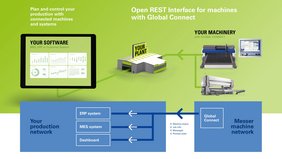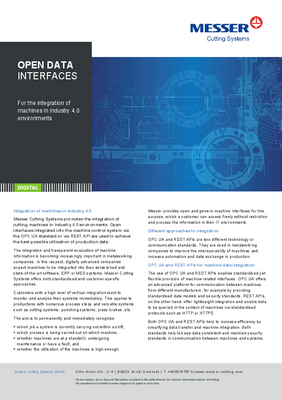Messer Cutting Systems promotes the integration of cutting machines in Industry 4.0 environments. Open interfaces integrated into the machine control system via the OPC UA standard or via REST API are used to achieve the best possible utilisation of production data.
The integration and transparent evaluation of machine information is becoming increasingly important in metalworking companies. In this respect, digitally advanced companies expect machines to be integrated into their established and state-of-the-art software, ERP or MES systems. Messer Cutting Systems offers both standardised and customer-specific approaches.
Customers with a high level of vertical integration want to monitor and analyse their systems immediately. This applies to productions with numerous process steps and versatile systems such as cutting systems, punching systems, press brakes, etc.
The aim is to permanently and immediately recognise
+ which job a system is currently carrying out within a shift,
+ which process is being carried out on which machine,
+ whether machines are at a standstill, undergoing maintenance or have a fault, and
+ whether the utilisation of the machines is high enough.
Messer provides open and generic machine interfaces for this purpose, which a customer can access freely without restriction and process the information in their IT environments.
Different approaches to integration
OPC UA and REST APIs are two different technology or communication standards. They are used in metalworking companies to improve the interoperability of machines and increase automation and data exchange in production.
OPC UA and REST APIs for machine data integration
The use of OPC UA and REST APIs enables standardised yet flexible provision of machine-related interfaces. OPC UA offers an advanced platform for communication between machines from different manufacturers, for example by providing standardised data models and security standards. REST APIs, on the other hand, offer lightweight integration and enable data to be queried in the context of machines via standardised protocols such as HTTP or HTTPS.
Both OPC UA and REST APIs help to increase efficiency by simplifying data transfer and machine integration. Both standards help to keep data consistent and maintain security standards in communication between machines and systems.
Industry standard OPC UA
OPC UA (Open Platform Communications Unified Architecture) is an industry standard for communication and data exchange between different machines and systems in industrial automation. It enables secure, reliable, and manufacturer-independent communication across different levels of a production facility.
Standardised models for data communication ensure that machines from different manufacturers can communicate with each other and exchange data, regardless of the hardware or software used.
Advantages of OPC UA:
+ Interoperability between machines from different manufacturers means that metalworking companies are not tied to specific suppliers and can seamlessly integrate machines from different manufacturers.
+ For example, the platform offers advanced security mechanisms, including encryption, authentication, and authorisation. This ensures secure data exchange and protects against unauthorised access.
+ OPC UA is flexible and enables easy scaling and integration of production systems into customer software environments.
+ New machines and systems can be easily integrated into existing networks. OPC UA offers standardised data models, which makes implementation and integration much easier.
+ It enables standardised communication between different levels and systems in production, for example to query a machine status.
REST APIs
REST APIs (Representational State Transfer Application Programming Interfaces) utilise a software architecture that is based on the REST principle and is used for communication between different computer systems via the internet.
In the context of machines in manufacturing, REST APIs are used to provide an interface for the exchange of data and commands between machines or systems. This exchange in higher-level production systems takes place via standardised protocols (HTTP/HTTPS).
Advantages of REST APIs
+ REST APIs offer a simple and easy-to-understand interface for integrating machines and systems into the company's IT infrastructure.
+ They enable seamless communication between different applications and platforms.
+ Based on the HTTP protocol, they are suitable for a wide range of applications and platforms. They can be used to integrate IoT devices, transfer data, control processes and much more.
+ REST APIs are easy to implement and use. They do not require any special libraries or protocols and can be used across platforms.
+ The interfaces enable the remote control of machines and the exchange of data in real time. This is particularly useful for process monitoring, analysis, and remote maintenance.
Maximising the benefits of machine data
With the help of OPC UA and REST APIs, companies utilise machine data in real time and integrate it into their own software environments. The data supplied provides deep insights into the status of machines, process details and error information and thus forms the basis for process optimisation.
Data availability and flexibility thanks to open interfaces
Thanks to the open interfaces, data is no longer tied solely to machine control systems and HMIs. They allow different departments to use the data and analyse it from different perspectives, which leads to a more differentiated evaluation.
The implementation of OPC UA and REST APIs therefore means a "democratisation of data", as it can be accessed at any time from different systems and locations. This openness enables machine data to be analysed comprehensively and promotes innovation in manufacturing and business processes.
Practical example 1: Integration with OPC UA
The Messer machine with the Global Control system will be equipped with an OPC UA server. This provides selected machine data, such as information on whether the machine is currently in operation, which processes are running on it or whether there is an error. Information on the pending job is also available. This information can be queried individually and made available outside the machine.
The machine is now located in the company's network. The company's own software environment is extended so that the machine acts as an OPC UA server and supplies the machine information.
This information can then be used in a variety of ways:
1. Live machine statuses are displayed in corresponding graphics using a low-code dashboard application. OPC UA makes it easy to integrate the Messer machines into very diverse machine parks with many different system manufacturers.
2. Information on each completed cutting job is used in the MES and ERP system for data analysis.
Practical example 2: Integration via REST interface
To integrate a Messer machine with Global Connect control, it is only necessary to have integrated the machine into the company network. The REST API is implemented on the machine controller.
The data from the machine is read out and processed with the help of a separate software application. A library is simply integrated into the existing software environment to read out REST endpoints.
REST API is also used to utilise information about the machine in various ways:
1. A dedicated website provides the status of the machines in production. This makes it possible to see at any time whether the machine is active. The Messer machine, which can be queried via REST API, can thus be integrated into the existing environment independently of the machine.
2. Job information is written to a low-code database application. Job information on material, thickness, start and end time and much more information is available for subsequent data analyses for each finished job.
Software solutions from Messer and their integration
Messer Cutting Systems networks machines and systems with software solutions such as the modularised OmniFab software suite. With comprehensive options for data evaluation, they offer significant added value when analysing data. OmniFab utilises ready-made, easy-to-integrate solutions from quotation creation to feedback of machine data from production.
The combination with OPC UA and REST APIs expands the possibilities for data integration and analysis. It is particularly important for customers with diverse machine parks from different manufacturers to integrate and standardise various data sources - with a high degree of freedom.
Machines as part of Industry 4.0
The use of OPC UA and REST APIs makes machines such as those from Messer Cutting Systems ready for integration into Industry 4.0. The open interfaces offer decisive added value for versatile and effective utilisation of machine data and promote innovation in manufacturing.
OPC UA acts as an interface that can bring together different data sources and enables a standardised data description. REST APIs offer simplified integration for specific requirements and support flexible data retrieval.
Overall, OmniFab, OPC UA and REST APIs offer metalworking companies the opportunity to optimise their manufacturing processes, drive automation, increase flexibility and ultimately boost competitiveness.
About the author
The author Manuel Schultheiß is a software specialist in product management at Messer Cutting Systems GmbH in Gross-Umstadt, Germany.
He is an expert with many years of experience in software, Industry 4.0 applications and software/machine interfaces.
Graphics: Messer Cutting Systems



